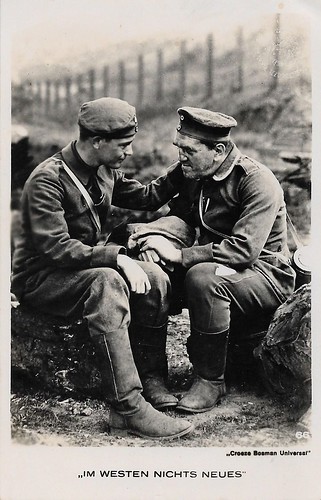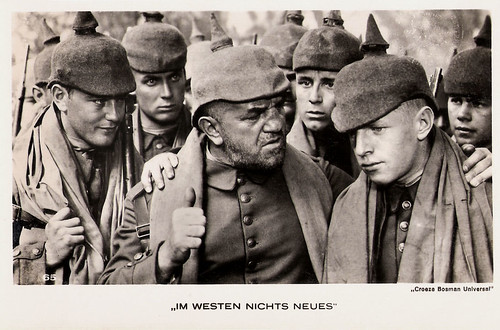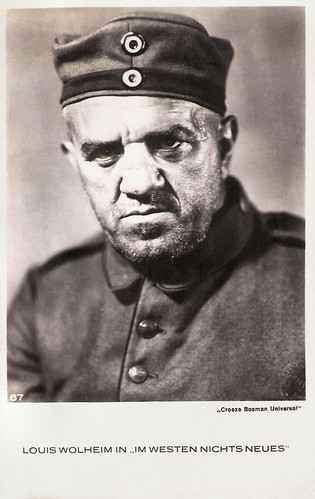The American anti-war-epic All Quiet on the Western Front (1930) was based on the novel Im Westen nichts neues by Erich Maria Remarque. It is a realistic and harrowing account of warfare in World War I. The film starred Lew Ayres and Louis Wolheim, was directed by Lewis Milestone and produced by Universal. It was the first film to win Oscars for both Best Film and Best Director.

Lew Ayres and Louis Wolheim. Dutch postcard by Croeze-Bosman-Universal, no. 66. Photo: publicity still for All Quiet on the Western Front (Lewis Milestone, 1930). Croeze-Bosman was a Dutch film distribution company, founded in 1926 as a continuation of the Dutch American Film co., a subsidiary of Universal.

Lew Ayres, Louis Wolheim and Owen Davis Jr. Dutch postcard by Croeze-Bosman-Universal, no. 65. Photo: publicity still for All Quiet on the Western Front (Lewis Milestone, 1930).
All Quiet on the Western Front (Lewis Milestone, 1930) is based on the acclaimed novel by Erich Maria Remarque. The film is unusual for a Hollywood war film because it is told from the viewpoint of the German soldiers fighting in World War I. The film portrays the transformations the young German soldier Paul (Lewis Ayres) suffers during the World War I: the innocence before the war and the promise of everlasting glory, the shock with reality and the realisation of his own mortality and of the hypocrisy of war and finally the return to the world away from the trenches, a world that didn't stop to wait for him.
The novel's title in German is Im Westen Nichts Neues, Nothing New in the West. Erich Maria Remarque draw the title from German newspaper articles. The articles would rave about glorious victories on the Eastern Front but dismiss the horrors playing out on the Western Front in a nothing-to-see-here-folks manner by the simple phrase, "nothing new in the west". Director Lewis Milestone filmed the novel only eleven years after the war ended. His film contains a power only possible by those who've lived through the era.
The film begins in a classroom. Outside, martial music is blaring and the professor inside the room is lecturing Paul and the other boys about their duty to the Fatherland and encouraging them all to as a group in the German army at the outbreak of WWI. The film captures the enthusiasm and naivete of the boys - as they imagine glory awaiting them after they enlist. Even in boot camp, the mood is light and the new recruits are excited about seeing their first action. This perfectly sets the stage for the actual war - the hellish and pointless mess that was WWI. The rest of the film is brutally honest and harsh and shows how the students die off one-by-one and the remaining students become more and more jaded and emotionally dead due to the fighting.
A highlight is the scene where Paul (Lew Ayres) mortally wounds a French soldier and then weeps bitterly as he fights to save his life while trapped in a shell crater with the body. The film is also remembered for the sequence with the butterfly at the end. Paul is back on the front lines. He sees a butterfly just beyond his trench. Paul smiles and reaches out towards the butterfly, but becoming too exposed, he is shot and killed by an enemy sniper. The iconic final shot with the hand and the butterfly was filmed during the editing process. All the actors had left so it is actually Lewis Milestone's hand we see in the final shot.
Universal Pictures produced the film for the then considerable sum of $1.25 million. It was also the first sound film of director Lewis Milestone. The fact that production began only a few months after the 1929 stock-market crash puts into perspective the enormous gamble taken by the studio in making this film. A special camera crane, built under the specifications of Pál Fejös for his film Broadway (1929), was brought to this film's location in Irvine and used for the battle scenes. The crane had its own concrete ramp, installed several months before at the location, allowed cameraman Arthur Edeson to film the extended tracking shots.
Lew Ayres plays Paul quite understated but very believable. His character is well-chosen as the focal point of most of the film. The liveliest of the soldiers is the resourceful Sergeant 'Kat'. Louis Wolheim earned some of the best notices of his career playing the Sergeant. He was set to star in Lewis Milestone's next film The Front Page (1931) when he unexpectedly died of stomach cancer in 1931. All Quiet on the Western Front (1930) was the second most popular film at the U.S. box office for 1930. Universal won it's first Best Picture Oscar for the film and it was the first ever film to win Academy Awards for Best Picture and Best Director.
In Germany, Nazi brownshirts under the command of Joseph Goebbels stormed screenings of All Quiet on the Western Front (Lewis Milestone, 1930), releasing white mice or stink bombs into the theatres. The wounds of defeat in the First World War still ran deep. This led to the film ultimately being banned by the Nazi party. The film was banned in Germany by Nazi Minister of the Interior Wilhelm Frick on the grounds that it ignominiously represented Germans as cowards. It wouldn't receive proper screenings in Germany until 1956, though it did play to packed houses in 1930 in neighbouring Switzerland, France and the Netherlands with special trains and buses being laid on to transport Germans to screenings. The film was also banned in fascist Italy until 1956. Ironically, in Poland, that country's censorship board proscribed the film on account of it's being 'pro-German'.

Owen Davis Jr. Dutch postcard by Croeze-Bosman-Universal, no. 64. Photo: publicity still for All Quiet on the Western Front (Lewis Milestone, 1930). Owen Davis Jr. played Peter in the film.

Louis Wolheim. Dutch postcard by Croeze-Bosman-Universal, no. 67. Photo: publicity still for All Quiet on the Western Front (Lewis Milestone, 1930).
Sources: Wikipedia and IMDb.

Lew Ayres and Louis Wolheim. Dutch postcard by Croeze-Bosman-Universal, no. 66. Photo: publicity still for All Quiet on the Western Front (Lewis Milestone, 1930). Croeze-Bosman was a Dutch film distribution company, founded in 1926 as a continuation of the Dutch American Film co., a subsidiary of Universal.

Lew Ayres, Louis Wolheim and Owen Davis Jr. Dutch postcard by Croeze-Bosman-Universal, no. 65. Photo: publicity still for All Quiet on the Western Front (Lewis Milestone, 1930).
The hellish and pointless mess that was WWI
All Quiet on the Western Front (Lewis Milestone, 1930) is based on the acclaimed novel by Erich Maria Remarque. The film is unusual for a Hollywood war film because it is told from the viewpoint of the German soldiers fighting in World War I. The film portrays the transformations the young German soldier Paul (Lewis Ayres) suffers during the World War I: the innocence before the war and the promise of everlasting glory, the shock with reality and the realisation of his own mortality and of the hypocrisy of war and finally the return to the world away from the trenches, a world that didn't stop to wait for him.
The novel's title in German is Im Westen Nichts Neues, Nothing New in the West. Erich Maria Remarque draw the title from German newspaper articles. The articles would rave about glorious victories on the Eastern Front but dismiss the horrors playing out on the Western Front in a nothing-to-see-here-folks manner by the simple phrase, "nothing new in the west". Director Lewis Milestone filmed the novel only eleven years after the war ended. His film contains a power only possible by those who've lived through the era.
The film begins in a classroom. Outside, martial music is blaring and the professor inside the room is lecturing Paul and the other boys about their duty to the Fatherland and encouraging them all to as a group in the German army at the outbreak of WWI. The film captures the enthusiasm and naivete of the boys - as they imagine glory awaiting them after they enlist. Even in boot camp, the mood is light and the new recruits are excited about seeing their first action. This perfectly sets the stage for the actual war - the hellish and pointless mess that was WWI. The rest of the film is brutally honest and harsh and shows how the students die off one-by-one and the remaining students become more and more jaded and emotionally dead due to the fighting.
A highlight is the scene where Paul (Lew Ayres) mortally wounds a French soldier and then weeps bitterly as he fights to save his life while trapped in a shell crater with the body. The film is also remembered for the sequence with the butterfly at the end. Paul is back on the front lines. He sees a butterfly just beyond his trench. Paul smiles and reaches out towards the butterfly, but becoming too exposed, he is shot and killed by an enemy sniper. The iconic final shot with the hand and the butterfly was filmed during the editing process. All the actors had left so it is actually Lewis Milestone's hand we see in the final shot.
Universal Pictures produced the film for the then considerable sum of $1.25 million. It was also the first sound film of director Lewis Milestone. The fact that production began only a few months after the 1929 stock-market crash puts into perspective the enormous gamble taken by the studio in making this film. A special camera crane, built under the specifications of Pál Fejös for his film Broadway (1929), was brought to this film's location in Irvine and used for the battle scenes. The crane had its own concrete ramp, installed several months before at the location, allowed cameraman Arthur Edeson to film the extended tracking shots.
Lew Ayres plays Paul quite understated but very believable. His character is well-chosen as the focal point of most of the film. The liveliest of the soldiers is the resourceful Sergeant 'Kat'. Louis Wolheim earned some of the best notices of his career playing the Sergeant. He was set to star in Lewis Milestone's next film The Front Page (1931) when he unexpectedly died of stomach cancer in 1931. All Quiet on the Western Front (1930) was the second most popular film at the U.S. box office for 1930. Universal won it's first Best Picture Oscar for the film and it was the first ever film to win Academy Awards for Best Picture and Best Director.
In Germany, Nazi brownshirts under the command of Joseph Goebbels stormed screenings of All Quiet on the Western Front (Lewis Milestone, 1930), releasing white mice or stink bombs into the theatres. The wounds of defeat in the First World War still ran deep. This led to the film ultimately being banned by the Nazi party. The film was banned in Germany by Nazi Minister of the Interior Wilhelm Frick on the grounds that it ignominiously represented Germans as cowards. It wouldn't receive proper screenings in Germany until 1956, though it did play to packed houses in 1930 in neighbouring Switzerland, France and the Netherlands with special trains and buses being laid on to transport Germans to screenings. The film was also banned in fascist Italy until 1956. Ironically, in Poland, that country's censorship board proscribed the film on account of it's being 'pro-German'.

Owen Davis Jr. Dutch postcard by Croeze-Bosman-Universal, no. 64. Photo: publicity still for All Quiet on the Western Front (Lewis Milestone, 1930). Owen Davis Jr. played Peter in the film.

Louis Wolheim. Dutch postcard by Croeze-Bosman-Universal, no. 67. Photo: publicity still for All Quiet on the Western Front (Lewis Milestone, 1930).
Sources: Wikipedia and IMDb.
No comments:
Post a Comment